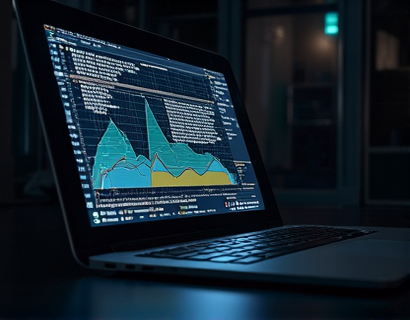Maximizing Digital Asset Value: Harnessing Smart Contracts for Long-Term Growth and Sustainable Fintech Innovation
The digital finance landscape is undergoing a transformative shift, driven by the integration of advanced technologies such as smart contracts. This evolution presents a unique opportunity for investors and participants in the fintech sector to maximize the value of their digital assets while ensuring sustainable growth and transparency. By leveraging smart contracts, it is possible to create a robust and secure environment that fosters long-term incentives and community-driven innovation.
Smart contracts, self-executing contracts with the terms directly written into code, offer a revolutionary approach to managing digital assets. These contracts automatically enforce and execute the agreed-upon terms without the need for intermediaries, reducing costs and increasing efficiency. In the context of digital assets, smart contracts can be used to lock in values, distribute incentives, and manage asset distribution in a transparent and reliable manner.
Securing Long-Term Locking for Digital Assets
One of the key benefits of using smart contracts in digital asset management is the ability to securely lock in assets for long-term periods. This locking mechanism ensures that assets are not sold or transferred prematurely, allowing investors to benefit from long-term growth trends. For instance, a smart contract can be programmed to lock a certain amount of digital currency for a specified duration, such as one, three, or five years. During this period, the assets remain untouched, growing in value as the market fluctuates.
This long-term locking strategy is particularly beneficial in volatile markets where short-term trading can lead to significant losses. By locking in assets, investors can ride out market downturns and capitalize on upward trends. Moreover, the use of smart contracts ensures that the locking period is enforced automatically, eliminating the risk of human error or manipulation.
Transparency and Reliability in Digital Asset Management
Transparency is a cornerstone of trust in any financial system, and smart contracts excel in this area. All transactions and contract states are recorded on a blockchain, a decentralized and immutable ledger. This means that every participant in the ecosystem can verify the status of the smart contract and the associated digital assets in real-time. Such transparency builds trust among users and reduces the likelihood of fraudulent activities.
Reliability is another critical aspect of smart contracts. Once deployed, a smart contract cannot be altered or tampered with, ensuring that the terms of the agreement are upheld consistently. This predictability is invaluable in a market where trust and reliability are paramount. Investors can have confidence that their assets will be managed according to the predefined rules, without the need for constant oversight.
Optimizing Returns through Smart Contract Solutions
Smart contracts can be designed to optimize returns for digital asset investors in several ways. One approach is to implement dynamic incentive structures that reward participants based on their contributions to the ecosystem. For example, a smart contract can distribute tokens or other digital assets to users who actively engage with the platform, such as by providing liquidity, participating in governance, or referring new users.
Another strategy is to use smart contracts to automate the reinvestment of profits or rewards. By setting up a automatic reinvestment mechanism, investors can ensure that their returns are compounded over time, leading to higher overall returns. This automated process removes the need for manual intervention, reducing the risk of errors and increasing efficiency.
Fostering a Thriving Community through Collaborative Innovation
The use of smart contracts in digital asset management is not just about maximizing individual returns; it is also about building a thriving community. By creating a transparent and reliable environment, smart contracts encourage collaboration and innovation among participants. Investors, developers, and other stakeholders can work together to enhance the ecosystem, introducing new features and improvements that benefit everyone.
For instance, a smart contract can facilitate a governance system where token holders vote on proposed changes to the platform. This decentralized governance model ensures that decisions are made in the best interest of the community, fostering a sense of ownership and engagement. Additionally, smart contracts can automate the distribution of community funds or grants to support projects and initiatives that align with the ecosystem's goals.
Driving Sustainable Fintech Growth
The integration of smart contracts in digital asset management contributes significantly to the sustainable growth of the fintech industry. By reducing the need for intermediaries and lowering transaction costs, smart contracts make financial services more accessible and efficient. This democratization of finance opens up opportunities for a broader range of participants, including those in underserved markets.
Moreover, the use of smart contracts promotes environmental sustainability by reducing the carbon footprint associated with traditional financial systems. Digital transactions require less physical resources and energy compared to paper-based processes, aligning with the growing global focus on sustainability.
Incentivizing Long-Term Value Creation
One of the most compelling aspects of smart contracts in digital asset management is their ability to incentivize long-term value creation. By designing smart contracts that reward long-term holders and penalize short-term speculative behavior, the ecosystem can shift towards a more stable and sustainable growth model. This approach aligns the interests of all participants, ensuring that everyone has a stake in the long-term success of the platform.
For example, a smart contract can implement a decay mechanism for certain tokens, reducing their supply over time and increasing their value. This mechanism encourages holders to keep their assets locked in for extended periods, contributing to the overall stability and growth of the ecosystem. Additionally, smart contracts can be programmed to release rewards or dividends to long-term holders, further incentivizing sustained participation.
Case Study: Smart-Contract Locking for UCASH
To illustrate the practical application of smart contracts in maximizing digital asset value, consider the example of a hypothetical project similar to Ucollateral, which focuses on locking in UCASH tokens for long-term incentives. In this scenario, a smart contract is deployed on a blockchain to manage the locking and unlocking of UCASH tokens.
The smart contract allows users to lock their UCASH tokens for a specified period, such as one year, in exchange for a locked-in reward. During the locking period, the tokens cannot be sold or transferred, ensuring that they remain invested in the ecosystem. At the end of the locking period, the user receives a bonus based on the performance of the ecosystem, such as additional UCASH tokens or other incentives.
This locking mechanism not only protects the investor's assets from market volatility but also aligns their interests with the long-term growth of the ecosystem. The transparent and reliable nature of the smart contract ensures that the terms are enforced without the need for intermediaries, building trust among users.
Conclusion
The integration of smart contracts in digital asset management represents a significant step forward in maximizing asset value, ensuring sustainable growth, and fostering a thriving fintech community. By leveraging the power of blockchain technology, smart contracts provide a secure, transparent, and reliable framework for managing digital assets. This approach not only benefits individual investors but also contributes to the overall health and innovation of the fintech industry.
As the digital finance landscape continues to evolve, the adoption of smart contracts will play a crucial role in shaping a more prosperous and sustainable future. By embracing this technology, participants can unlock new opportunities for growth, collaboration, and value creation, paving the way for a decentralized and equitable financial system.









































